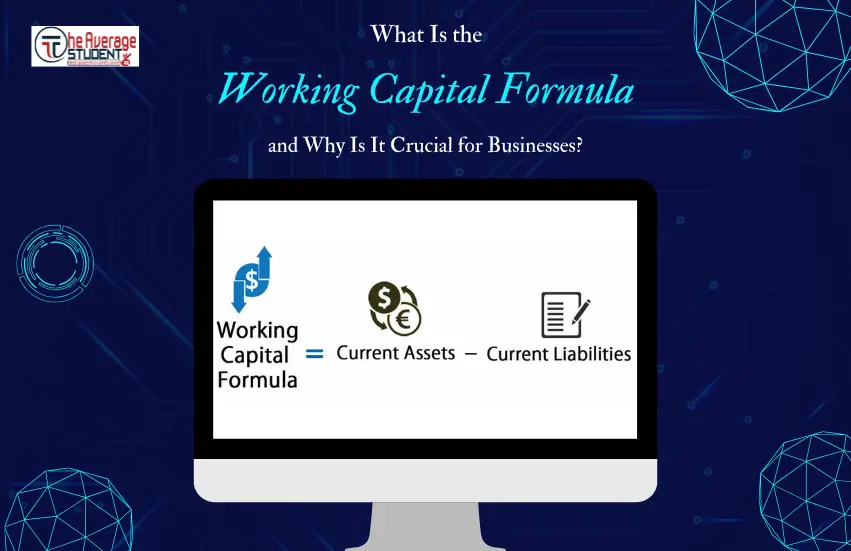In the competitive and ever-evolving world of business, financial management plays a pivotal role in a company’s ability to thrive and grow. Among the various financial metrics and tools that businesses use to assess their financial health, the working capital formula stands out as a crucial component. Understanding what the working capital formula is, how it relates to the working capital cycle, and why it is essential for business operations is indispensable for any business manager or entrepreneur aiming for success.
Understanding the Working Capital Formula
At its core, the working capital formula is a simple calculation used to determine a company’s short-term liquidity. It enables businesses to understand their financial health by examining their ability to cover short-term obligations with short-term assets. The formula is expressed as:
WorkingCapital=CurrentAssets−CurrentLiabilitiesWorking Capital = Current Assets – Current LiabilitiesWorkingCapital=CurrentAssets−CurrentLiabilities
Current Assets: These are assets that a company expects to convert into cash within a year and typically include cash, accounts receivable, inventory, and other liquid assets.
> Current Liabilities: These are a company’s obligations that are due to be settled within a year, such as accounts payable, short-term debt, and other similar liabilities.
A positive working capital indicates that a company has enough short-term assets to cover its short-term liabilities, suggesting sound financial health. Conversely, a negative working capital can indicate potential liquidity problems, signaling that the company might struggle to meet its short-term obligations.
The Importance of the Working Capital Formula
- Liquidity Assessment: The working capital formula provides businesses with a clear picture of their liquidity position. This is crucial for maintaining day-to-day operations, as businesses need adequate liquidity to pay bills, purchase inventory, and meet other financial commitments.
2. Operational Efficiency: By consistently monitoring working capital, businesses can ensure they are operating efficiently. Excessive working capital might indicate under-utilized resources, while insufficient working capital might suggest over-eagerness to deploy resources, risking liquidity challenges.
3. Investment Opportunities: Companies with well-balanced working capital can also seize investment opportunities quickly. When a business has positive working capital, it has greater flexibility to invest in growth opportunities. Such as expanding operations or acquiring new assets.
4. Risk Management: The working capital formula helps businesses identify potential financial risks early. By understanding their working capital situation, companies can take proactive measures to address financial shortfalls before they become severe.
5. Creditworthiness and Relationships: Maintaining a positive working capital enhances a company’s creditworthiness. Lenders and suppliers typically assess a company’s working capital to determine its ability to honor financial commitments, which influences terms of credit and trade.
Exploring the Working Capital Cycle
Closely related to the working capital formula is the concept of the working capital cycle. The working capital cycle refers to the time it takes for a company to convert its net current assets and liabilities into cash. In other words, it is the duration between purchasing inventory and collecting cash from sales.
The working capital cycle involves four main stages:
- Inventory Purchase: The cycle starts with purchasing raw materials or stock needed for production or sale.
2. Production and Sales: The next stage involves converting the inventory into finished goods and selling them to customers.
3. Accounts Receivable: After a sale, the company records accounts receivable if the sale was made on credit. This reflects the period a company must wait to receive payment from customers.
4. Accounts Payable: Finally, accounts payable are settled, marking the end of the cycle when the initial suppliers are paid.
The goal for businesses is to optimize this cycle to ensure they can recover their cash investment in inventory as quickly as possible, thereby minimizing the amount of cash tied up in operations.
Why the Working Capital Cycle Matters
- Cash Flow Optimization: Understanding and managing the working capital cycle helps businesses optimize their cash flow. Shorter cycles mean faster cash conversion, which enhances liquidity and financial stability.
2. Supplier and Customer Relations: Efficient management of the working capital cycle can lead to better negotiations with suppliers regarding payment terms and also allow the extension of favorable terms to customers without negatively impacting cash flow.
3. Cost Management: A well-managed working capital cycle can help reduce costs associated with holding inventory or risking obsolescence. It also minimizes financing costs related to borrowing due to cash shortages.
4. Strategic Planning: Companies that have a clear understanding of their working capital cycle are better positioned to make strategic decisions regarding inventory management, market expansion, and even downturn preparedness.
Conclusion
The working capital formula and working capital cycle are fundamental metrics for assessing and managing a company’s short-term financial health. They provide crucial insights into a business’s liquidity and operational efficiency. Which are essential for sustaining day-to-day operations and seizing growth opportunities. By mastering these concepts, business owners and financial managers can better navigate the complexities of financial management. Ensuring their businesses remain resilient and competitive in an ever-changing marketplace. In today’s fast-paced business environment, understanding the nuances of working capital management can be the difference between thriving and merely surviving. Focusing on these critical financial factors will equip businesses to make informed decisions, maintain robust cash flows, and achieve long-term success.




